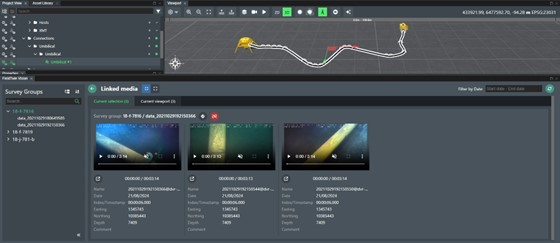FieldTwin Vision¶
FieldTwin Vision is an integration in the FieldTwin platform that allows account administrators to upload and process the data captured by the remotely operated vehicles (ROVs) used for the critical inspection and maintenance of underwater assets, encompassing pipelines, wells, and other equipment.
The processed data can be accessed through the FieldTwin Designer part of the integration by any user of the account. It significantly enhances their ability to monitor, analyze, and make informed decisions.
Installation¶
In FieldTwin Admin, go to Account Settings, then Integrations, and click Create New Tab. Set the following values:
- Name: FieldTwin Vision
- URL: https://ft-vision-frontenduser.TBD/
- Account Settings URL: https://ft-vision-frontendadmin.TBD/
- Use GET verb: yes
- Do not pass arguments in URL: yes
- Tab Display Position: Module Panel (default)
Configuration¶
In FieldTwin Admin, go to Account Settings, then Integrations, FieldTwin Vision (or the name you entered in the installation above) and click Settings.

FieldTwin Vision Admin¶
In FieldTwin Vision Admin you will set up survey groups, manage video uploads and more.
Survey Groups tree view¶
This is where the account administrator can create new survey media groups and subgroups or edit and delete existing ones.
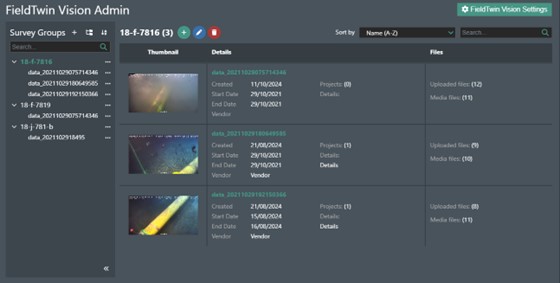
FieldTwin Vision Settings¶
The FieldTwin Vision settings are mainly used to save different column mapping options for the coordinates and comments files. These are needed in order to successfully process the CSV files with coordinates or the Excel files with comments (available only through the FieldTwin Designer part of the integration). Also, it is possible to set up the Azure Blob Storage information if survey files need to be uploaded from there. To access the settings, click on the “FieldTwin Vision Settings” button.

Coordinates files column mapping and formats:
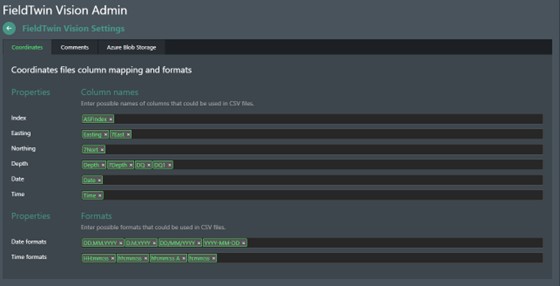
Comments files column mapping:
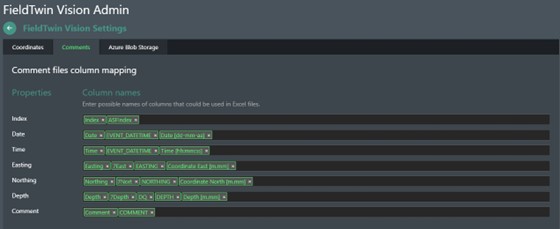
Comments settings
To add a new column mapping, click on the desired property field and input the new mapping. To delete an existing mapping, either click on the X next to each mapping or just backspace with the keyboard. Exiting the field saves the changes automatically.
Azure Blob Storage settings:

A SAS token, storage account name and container name are required in order to allow file sharing to the FieldTwin Vision integration.
Survey Groups tree view actions
The tree view actions can be seen here:

Tree View Actions
 - add new main group.
- add new main group.
 - expand the main groups list when it is collapsed or collapse it when expanded.
- expand the main groups list when it is collapsed or collapse it when expanded.
 - sort the groups alphabetically (A-Z) or (Z-A).
- sort the groups alphabetically (A-Z) or (Z-A).
The search bar allows you to find any group or subgroup by its name. At the bottom is a button for hiding the tree.

The double arrows can be used to expand the tree back to its original size.
When adding a new main group, a dialog will appear:

Next to every group, there is a hamburger menu, where you can select actions:
For the main groups - add a new subgroup, rename it or delete it.

For the subgroups: - move it to another main group, rename it or delete it.

Upon selecting a main group, the options for adding a new subgroup, renaming and deleting can also be accessed by this menu above the subgroups list.

Main group icon actions
 - add new subgroup.
- add new subgroup.
 - rename the main group.
- rename the main group.
 - delete the main group
- delete the main group
On the right side, there are options for sorting and searching the main group in order to find a specific subgroup. The default sorting is by the subgroup names (A-Z), but you can change it to one of the following options:
- Newest First
- Name (A-Z)
- Name (Z-A)
- Start date
- End date
- Vendor
You can search by any of those parameters in the search bar.

Main groups sort and search
Create a new subgroup¶
To create a new subgroup, select the “Add New Subgroup” option from the hamburger menu or click on the icon.

A new page will load to the right side of the tree view.
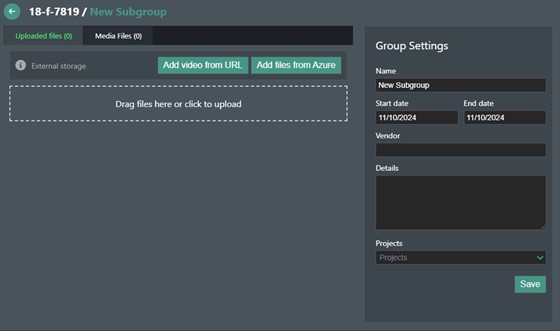
If you wish, you can change the group settings by entering:
- A new subgroup name
- Start date
- End date
- Vendor
- Details
It is necessary to link the subgroup to a project from the “Projects” dropdown, so it can appear in the FiedTwin Designer part of the integration. After entering all the information about the new subgroup, click the “Save” button to save the changes.
Uploading survey files¶
For uploading survey files, there are three options:
Add files from Azure¶
If the Azure Blob Storage settings are properly configured and a valid SAS token is provided, you can click on the “Add files from Azure” button and a file explorer will open.

This will then present the following:
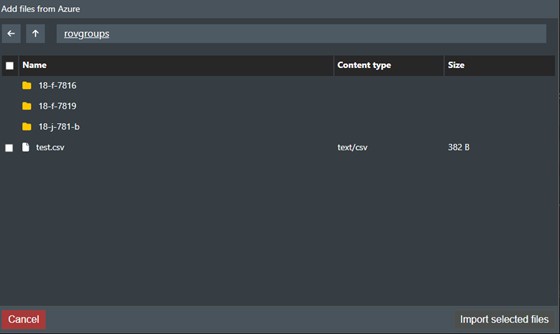
Select the needed survey files by clicking on the checkbox next to them and press the “Import selected files” button.

All files can be selected at once using the checkbox at the top. Files added from an external source are uploaded, except for the videos. Their URL references are saved in the ‘Media Files’ tab.
Add video from URL¶
Click on the “Add video from URL” button.

and this popup will appear.
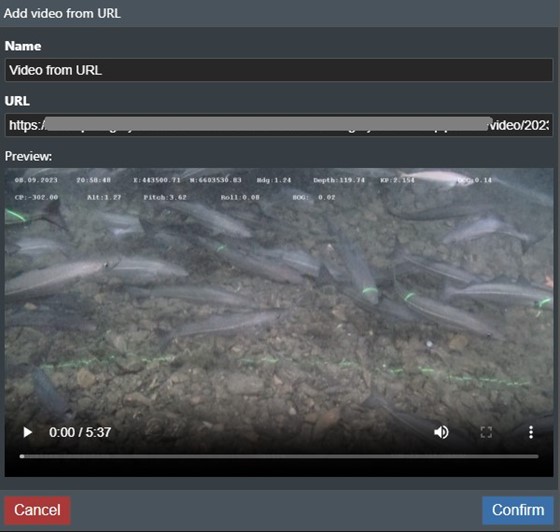
Enter a name and a valid URL for the video and click “Confirm”. The video file will appear in the “Media Files” tab.
Manual upload¶
You can either click on the file upload zone or drag and drop files to it.
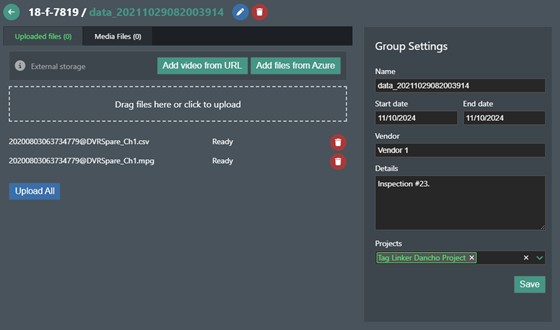
After choosing the desired files, click on the “Upload All” button.
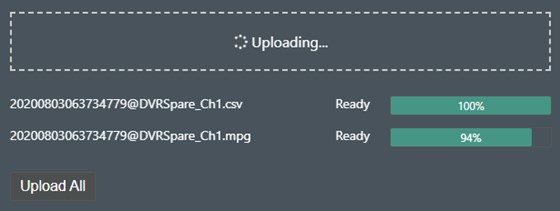
The files will be transferred to the “Uploaded files” section, where you can see their type, name, when they were uploaded, process them, download or delete them.

Create Survey Path¶
To make the uploaded video and CSV files usable by the FieldTwin Designer part of the integration, you need to process the videos and generate a survey path.
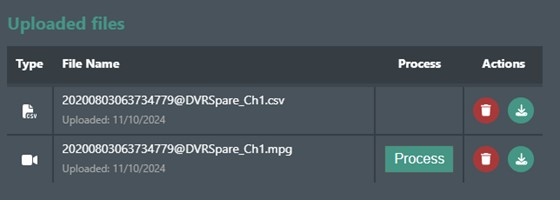
Initiate the video processing by clicking the “Process” button next to each video file.

Generate a survey path by clicking the “Generate path” button.

Then select a CSV file from which the path coordinates will be generated and click the “Proceed” button.
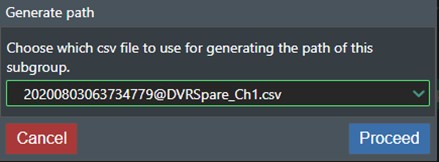
If the CSV file contains dates, but the format is missing from the FieldTwin Vision Settings, an informative popup will appear.

If the CSV file dates are valid, but they differ from the ones in the subgroup settings, a popup will appear, asking to update them automatically.

If the CSV file has columns that are required for the coordinates generation, but are missing from FieldTwin Vision Settings, this popup is displayed, asking for manual link.
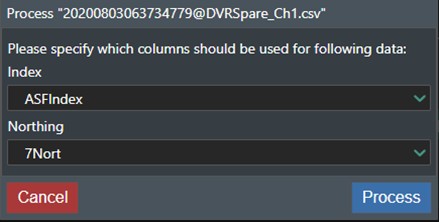
After this, these missing columns will be automatically saved in the settings and the popup will not be shown again.
All processed files will appear in the “Media Files” tab, where you can see their type, name, updated date, and download or delete them.

Media files¶
The first processed video will automatically be set as a cover, meaning that a frames from it will be used for the thumbnail of the subgroup. If you have more than one processed video, a new option would appear, allowing you to set any video as the cover.

Video file in media files
 - set video as cover.
- set video as cover.
 - delete file.
- delete file.
 - download file.
- download file.
Move a subgroup¶
To move a subgroup to another main group, select the “Move to…” option and choose the main group, where you want to move the current subgroup to from the dropdown input. Click “Confirm” to complete the transfer.

Rename a group¶
To rename a group, select the “Rename” option from the hamburger menu or click on the icon next to the group’s name.
![]()
Enter the new group name and click “Confirm”.
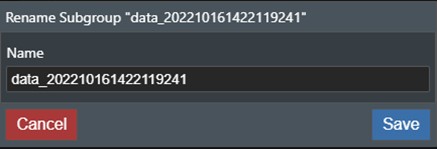
Delete a group¶
To delete a subgroup, select the “Delete” option from the hamburger menu or click on the icon next to the group’s name.
![]()
This will present the following dialog:

You will need to confirm the deletion.
Note! Deleting a main group will also delete all of the subgroups within it as shown below.

Main list of subgroups¶
Upon selecting a main group, a list of its contained subgroups will appear. The list of subgroups contains three columns:
- Thumbnail, which is a set of images taken when the cover video was processed.
- Details, which are filled when creating each subgroup.
- Files, which shows the uploaded and media files of the subgroup.

Clicking on the name of any subgroup will change the current view from the main group list to the currently selected subgroup’s page.

FieldTwin Vision User¶
The FieldTwin Vision User integration can be accessed through FieldTwin Designer. To do so, click on “Layout”, then “FieldTwin Vision” or however you have named the integration in the admin part.

This is how the FieldTwin Vision User integration looks like.

Tree view

The tree view allows you to access all available main groups and subgroups for the current project. These are the tree actions.
Tree view actions
![]() - expand the main groups list when it is collapsed or collapse it when expanded.
- expand the main groups list when it is collapsed or collapse it when expanded.
![]() - sort the groups alphabetically (A-Z) or (Z-A).
- sort the groups alphabetically (A-Z) or (Z-A).
Searching by name is available for any group within the tree.
At the bottom is a button for hiding the tree.
![]() - shrink the horizontal size of the tree.
- shrink the horizontal size of the tree.
You can click the double arrows again to expand the tree back to its original size.
Main groups list¶
Upon selecting a main group, you will see its name and the number of contained subgroups. On the middle, there are options for sorting the subgroups and searching for any of their properties.

Main groups sort and search
The default sorting is by the subgroup names (A-Z), but you can change it to one of the following options:
- Newest First
- Name (A-Z)
- Name (Z-A)
- Start date
- End date
- Vendor
The subgroups are presented inside a table, each having a thumbnail from its cover video if available, details and ROV path toggling action

The details include:
- Name of the subgroup.
- Created.
- Start Date.
- End Date
- Vendor.
- Details.
Clicking on “Show” creates the virtual ROV path and the viewport is automatically zoomed on it.
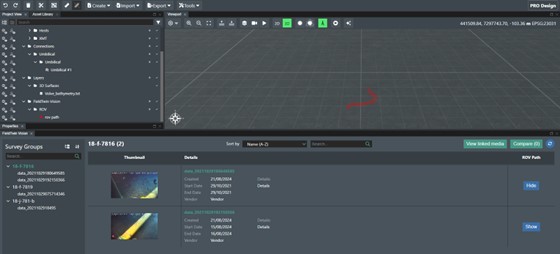
Subgroup view¶
Upon opening a subgroup, this screen will open:

Top view menu
In the top view menu, you can see the main group’s name, the current subgroup’s name the subgroup’s action icons.

Subgroup top menu
![]() - hover to view the detailed information about the subgroup.
- hover to view the detailed information about the subgroup.
![]() - toggle on and off the virtual ROV asset.
- toggle on and off the virtual ROV asset.
![]() - toggle on and off the virtual ROV path.
- toggle on and off the virtual ROV path.
![]() - link one or many selected objects in the viewport to this subgroup. Those objects will then appear in the “Linked objects” tab, where you can view and unlink them.
- link one or many selected objects in the viewport to this subgroup. Those objects will then appear in the “Linked objects” tab, where you can view and unlink them.
![]() - generate coordinates for the subgroup by selecting a connection asset in the viewport and clicking on this icon. Note that you can only generate coordinates for the subgroup if you haven’t already done so in the Admin part of the integration using a CSV file.
- generate coordinates for the subgroup by selecting a connection asset in the viewport and clicking on this icon. Note that you can only generate coordinates for the subgroup if you haven’t already done so in the Admin part of the integration using a CSV file.
![]() - remove coordinates, generated from a connection asset.
- remove coordinates, generated from a connection asset.
Toggling on the ROV asset and path will display them on the viewport like this. The ROV is moved to its coordinate position for each index of the video.
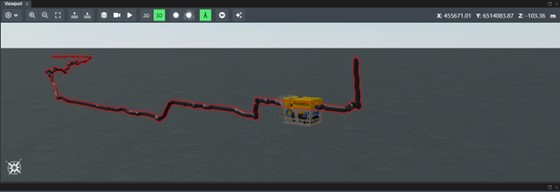
ROV path and asset visualized
Clicking on the button for generating coordinates from a connection asset after selecting one will open a popup, which asks for a confirmation of the starting point of the inspection.

Clicking on “Generate coordinates” will trigger the generation.
After the subgroup coordinates are generated from a connection asset, the button for generating them will be replaced with a new button, which allows to remove them. Clicking on it will open a confirmation popup

Video Controls¶
You can switch between all the processed videos within the subgroup by navigating to the desired one through this menu.

Underneath this menu is the video player. It is a default browser player, that you can use to play and pause the video or drag the slider to go to a specific time. You can also mute and unmute it, change the playback speed, download it or choose to open it in picture in picture mode.
Below the video player, you can find the custom controls menu.

and the icons represent the following functionality:
![]() - hover to view the video name.
- hover to view the video name.
![]() - enable or disable the Picture in Picture mode.
- enable or disable the Picture in Picture mode.
![]() - add this video for a comparison view, that can be accessed by clicking on the “Compare” button in the top right corner.
- add this video for a comparison view, that can be accessed by clicking on the “Compare” button in the top right corner.
Subgroup tabs¶
There are four tabs for each subgroup.

In the “Coordinates” tab you can find the processed CSV coordinates or the automatically generated ones. They include the video index/timestamp, easting, northing, depth, date, time and comments.
The current video index is marked in orange color and it changes every second if the video is running.

Coordinates tab¶
On the right side of the Comments column is the current comment number and the total amount of comments for these coordinates, together with buttons to move to the next and previous comments.

The icons represent the following functionality:
![]() - move to the previous comment.
- move to the previous comment.
![]() - move to the next comment.
- move to the next comment.
To the right is the menu for managing the comments.
![]() - toggle the visibility of all comments for the current video inside the viewport.
- toggle the visibility of all comments for the current video inside the viewport.
![]() - import comments from an Excel file.
- import comments from an Excel file.
![]() - remove all of the comments for the current video.
- remove all of the comments for the current video.
There are two options for adding comments.
Import from an Excel file.¶
You can upload an Excel file.

Drop your Excel file on it and wait a few seconds for it to be uploaded and processed. A new screen will be shown, asking you to select from which sheet to import the comments and which index is the header row of the table.

The start date and time will be prefilled with the first entry of the raw log table if available. If the table doesn’t contain all necessary columns, you will be asked to pick a column to map each missing one. If index column isn’t found, you will be asked to specify the start date and time of the inspection. Note that even the seconds are important in order to match the comments to the current coordinate index.

All missing columns will be saved for future use and you won’t be asked to fill them again if your Excel table doesn’t change. After all of the columns have been verified, the “Import” button will activate and you can click it to finalize the comments import. You will see all of the imported comments in the visualization by default. Using the eye icon next to the import icon will toggle the visibility of all of the comments for the current video.
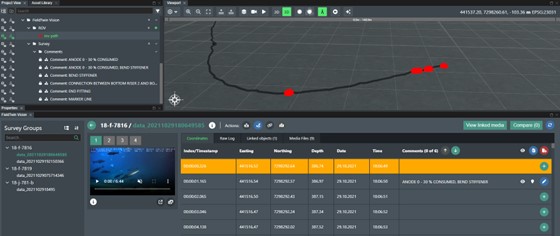
Manual Input¶
Clicking on the icon shown below for the desired index.
![]()
This will show the input comment field:

Enter the comment text in the newly opened input field and click the checkmark icon to save the comment or "X" icon to cancel.
After saving, the comment will be created and you will see the icons at the end change.

The icons below have the following functionality for single comment view:
![]() - toggle the visibility of the comment inside the viewport.
- toggle the visibility of the comment inside the viewport.
![]() - locate the comment inside the viewport
- locate the comment inside the viewport
![]() - edit the comment.
- edit the comment.
If the comment is visible, a red sphere will be shown on its location inside the viewport. Clicking on any of the comment spheres along the ROV path will make the current video and coordinates jump to this location.

In the “Raw log” tab you can find a table with all of the columns from the unprocessed CSV file. It highlights the current video index in orange color just like the coordinates tab

If the raw log columns pointing to the easting, northing and depth contain values that differ more than 1000 meters from the previous valid value, they will be marked as invalid and the row will be skipped in the coordinates tab.

In the “Linked objects” tab you can see all of the linked objects to the current subgroup, locate them and unlink them.

For the Linked objects tab the icons have the following functionality:
![]() - locate the linked object.
- locate the linked object.
![]() - unlink the object from the subgroup.
- unlink the object from the subgroup.
In the “Media files” tab you can see all of the processed video files, the coordinates file, and any other file that the administrator has uploaded. Available is the file name, when it was created and updated, and an option to download it
Linked Media¶
Click on the “View linked media” button to enter the Linked media view.

There are two tabs inside - “Current selection” and “Current viewport”.
Current selection¶
When you select an object in the viewport that is linked to any of the available subgroups, you will see the subgroups and their videos appear on the screen.
Next to the subgroup’s name, there are options to:
 - go to the subgroup containing the linked media.
- go to the subgroup containing the linked media.
 - unlink the subgroup from the selected objects objects.
- unlink the subgroup from the selected objects objects.
Upon trying to unlink, a confirmation popup will appear.

Underneath each video player, there is an option to open the video in a popup:
 - toggle the video popup.
- toggle the video popup.
Many popups can be opened at once and distributed to different monitors on full-screen, but there might be a performance issue when more than three videos are playing at the same time.
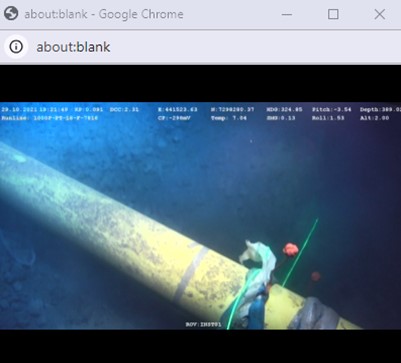
Switching between these buttons enlarges and shrinks the video size.
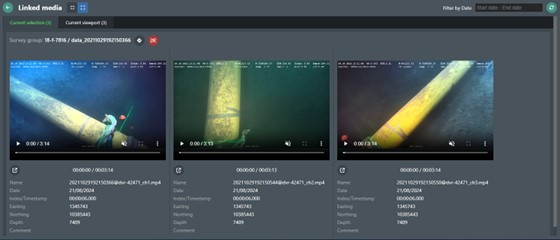
There is also an option to filter the subgroups by date. A specific range can be selected by first clicking on the start date, then the end date. Predefined ranges like last week, last month, last year, etc. are also available.

Current viewport¶
Shows all of the linked subgroups and their videos to all objects that fit within the current viewport.

If you have moved the current viewport after opening this view, you will have to click on the icon in to top right corner as shown below to refresh the data and see the updated result.

Compare view¶
There are two modes for the Compare view:

Compare by Date & Time¶
At the top, you will see a synchronized player, where you can play, pause and stop all of the selected videos at once, and also jump to the next and previous comment from all videos.

Video Player Controls
 - play all videos.
- play all videos.
 - pause all videos.
- pause all videos.
 - stop all videos.
- stop all videos.
 - move to the previous comment.
- move to the previous comment.
 - move to the next comment.
- move to the next comment.
For each video, you can see information about their name, date, current index/timestamp, easting, northing, depth and comment. If the videos are playing, these current properties will update every second, allowing you to not only compare the pure videos, but also the comments for each index.
Underneath each video are icons for toggling the video popup and removing the video from the comparison.
 - toggle video popup.
- toggle video popup.
 - remove the video from the comparison.
- remove the video from the comparison.
At the top right corner is the “Remove All” button, which will empty the comparison list.
Compare by Location¶
This comparison mode allows for a selection or a manual input of coordinates and a radius, which can be used to filter and show the videos that are located in this range radius.

Location actions:
 - toggles the selection mode, which allows you to select an asset and automatically fill in the coordinates.
- toggles the selection mode, which allows you to select an asset and automatically fill in the coordinates.
 - finds the location center sphere.
- finds the location center sphere.
Range radius actions:
 - finds the radius sphere.
- finds the radius sphere.
 - toggles the radius sphere.
- toggles the radius sphere.
After manually inputting the location by entering the X, Y, and Z coordinates or using the automated selection tool, you should click on the “Filter” button and if there are any videos from this location, they will be shown as illustrated below:

